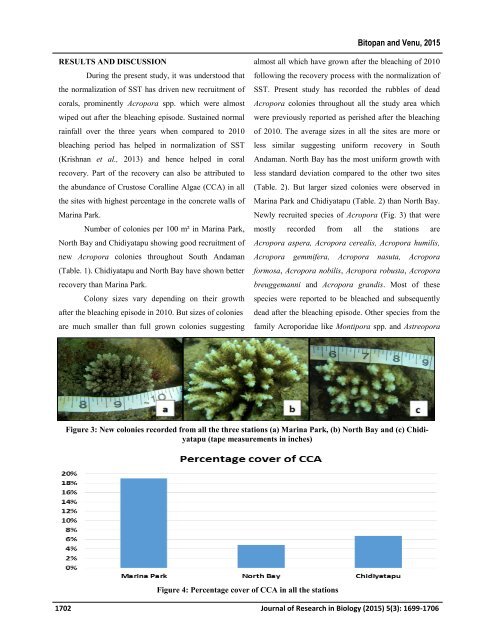New recruitment of Acropora Oken, 1815 in South Andaman- A proof of recovery of Corals after 2010 mass bleaching
Create successful ePaper yourself
Turn your PDF publications into a flip-book with our unique Google optimized e-Paper software.
Bitopan and Venu, 2015<br />
RESULTS AND DISCUSSION<br />
Dur<strong>in</strong>g the present study, it was understood that<br />
the normalization <strong>of</strong> SST has driven new <strong>recruitment</strong> <strong>of</strong><br />
corals, prom<strong>in</strong>ently <strong>Acropora</strong> spp. which were almost<br />
wiped out <strong>after</strong> the bleach<strong>in</strong>g episode. Susta<strong>in</strong>ed normal<br />
ra<strong>in</strong>fall over the three years when compared to <strong>2010</strong><br />
bleach<strong>in</strong>g period has helped <strong>in</strong> normalization <strong>of</strong> SST<br />
(Krishnan et al., 2013) and hence helped <strong>in</strong> coral<br />
<strong>recovery</strong>. Part <strong>of</strong> the <strong>recovery</strong> can also be attributed to<br />
the abundance <strong>of</strong> Crustose Corall<strong>in</strong>e Algae (CCA) <strong>in</strong> all<br />
the sites with highest percentage <strong>in</strong> the concrete walls <strong>of</strong><br />
Mar<strong>in</strong>a Park.<br />
Number <strong>of</strong> colonies per 100 m² <strong>in</strong> Mar<strong>in</strong>a Park,<br />
North Bay and Chidiyatapu show<strong>in</strong>g good <strong>recruitment</strong> <strong>of</strong><br />
new <strong>Acropora</strong> colonies throughout <strong>South</strong> <strong>Andaman</strong><br />
(Table. 1). Chidiyatapu and North Bay have shown better<br />
<strong>recovery</strong> than Mar<strong>in</strong>a Park.<br />
Colony sizes vary depend<strong>in</strong>g on their growth<br />
<strong>after</strong> the bleach<strong>in</strong>g episode <strong>in</strong> <strong>2010</strong>. But sizes <strong>of</strong> colonies<br />
are much smaller than full grown colonies suggest<strong>in</strong>g<br />
almost all which have grown <strong>after</strong> the bleach<strong>in</strong>g <strong>of</strong> <strong>2010</strong><br />
follow<strong>in</strong>g the <strong>recovery</strong> process with the normalization <strong>of</strong><br />
SST. Present study has recorded the rubbles <strong>of</strong> dead<br />
<strong>Acropora</strong> colonies throughout all the study area which<br />
were previously reported as perished <strong>after</strong> the bleach<strong>in</strong>g<br />
<strong>of</strong> <strong>2010</strong>. The average sizes <strong>in</strong> all the sites are more or<br />
less similar suggest<strong>in</strong>g uniform <strong>recovery</strong> <strong>in</strong> <strong>South</strong><br />
<strong>Andaman</strong>. North Bay has the most uniform growth with<br />
less standard deviation compared to the other two sites<br />
(Table. 2). But larger sized colonies were observed <strong>in</strong><br />
Mar<strong>in</strong>a Park and Chidiyatapu (Table. 2) than North Bay.<br />
<strong>New</strong>ly recruited species <strong>of</strong> <strong>Acropora</strong> (Fig. 3) that were<br />
mostly recorded from all the stations are<br />
<strong>Acropora</strong> aspera, <strong>Acropora</strong> cerealis, <strong>Acropora</strong> humilis,<br />
<strong>Acropora</strong> gemmifera, <strong>Acropora</strong> nasuta, <strong>Acropora</strong><br />
formosa, <strong>Acropora</strong> nobilis, <strong>Acropora</strong> robusta, <strong>Acropora</strong><br />
breuggemanni and <strong>Acropora</strong> grandis. Most <strong>of</strong> these<br />
species were reported to be bleached and subsequently<br />
dead <strong>after</strong> the bleach<strong>in</strong>g episode. Other species from the<br />
family Acroporidae like Montipora spp. and Astreopora<br />
Figure 3: <strong>New</strong> colonies recorded from all the three stations (a) Mar<strong>in</strong>a Park, (b) North Bay and (c) Chidiyatapu<br />
(tape measurements <strong>in</strong> <strong>in</strong>ches)<br />
Figure 4: Percentage cover <strong>of</strong> CCA <strong>in</strong> all the stations<br />
1702 Journal <strong>of</strong> Research <strong>in</strong> Biology (2015) 5(3): 1699-1706

















